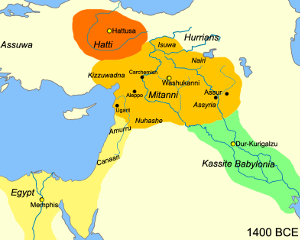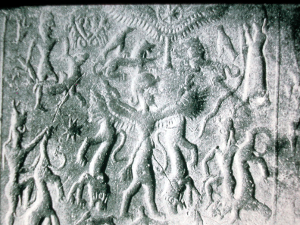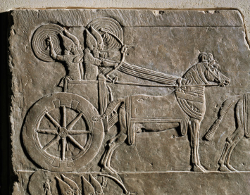The Mittani
The Mittani were an ancient people who lived in what is now northern Iraq and Syria and southeastern Turkey. At the time, they were northern neighbors to the powerful Assyrian Empire. Like other peoples of that time period, Mittani enjoyed ebbs and flows, conquered and were conquered, and traded and otherwise interacted with most other ancient civilizations. The Mittani were most closely related to the Hittites, who were, in turn, their northern neighbors. They fought off and on through many years but also enjoyed years of peace thanks to a treaty that encouraged the sharing of knowledge and language. The Mittani spoke a language known as Hurrian. The Hittites called them Hurri. The Egyptians referred to the Mittani as Nahrin, and the Assyrians named them the Hanigalbat. 
Washukanni was the capital of the Mittani lands. This important city was on the River Habur, a tributary of the famous Euphrates River. Other important Mittani cities were Aleppo, Carchemish, Karkemis, and Nuzi. Another city, Taite, is sometimes referred to as an alternate or second capital. Mittani lands extended from the Tigris River in the east to the Mediterranean Sea in the west. Mittani traditions tell of the first king, named Kirta, who united a number of tribes under a common banner and then passed on the crown to his sun Suttarna, who gave power in turn to his son, Paratarma. It this king who is thought to have done battle with Egypt's King Tuthmose I around the turn of the 15th Century B.C. 
The height of the civilization was from about 1475 B.C. to about 1275 B.C. During this time, the Mittani controlled much of northern Assyria and the important cities of Ashur and Nineveh. The sack of Ashur, the Assyrian capital, resulted in Mittani King Shaushtatar's taking the golden doors of the royal palace back with him to Washukanni. 
This military success was due in part to their use of the war chariot, a two-horse-drawn spoked-wheel cart that was lighter and more maneuverable than those crafted by the Sumerians. Mittani warriors riding in such chariots fired arrows and threw javelins and also used the chariots to trample opponents. In the same vein, excavations at the Hittite site of Hattusa, in what is now Turkey, have unearthed a horse training manual written by a Mittani trainer. The Mittani were also part of a multi-civilization alliance that fought against the Egyptians at the famous Battle of Megiddo. Also during this time, however, a succession crisis plagued the Mittani and resulted in an internal conflict that resulted in the neighboring Hittites' allying themselves with one side and capturing Washukanni. The pharaoh Thutmose IV had concluded a peace treaty with the Mittani king Artatama I. The Mittani king at the time of the uprising, Tushratta, had offered his own daughter in marriage to the Egyptian king, Amenhotep III, and that was enough for Egypt to support Tushratta initially. After a time, Egypt grew wary of alienating the Hittites and refused any further support of the Mittani king. The result was a Hittite takeover, led by King Suppiluliuma I. The opportunistic Assyrians, under King Shalmaneser I, regained territory that they had lost to the Mittani and then sacked Washukanni itself about 1290 B.C. The Mittani civilization seems to have faded into obscurity after that. The Mittani were known to be savvy agriculturalists, employing the two-field system of leaving one field fallow for a year in order to refresh the soil. They also bred sheep for wool and textiles, both of which were exported around the region. Trade between the Mittani and their neighbors was extensive. What is known about this ancient civilization comes from sources in other civilizations, such as the Amarna Letters: No Mittani sources remain. |
|
Social Studies for Kids
copyright 2002–2026
David White




